
11 Key Customer Engagement Metrics To Measure (2025)
Have you ever wondered how businesses know if their customers are happy and engaged? It’s all about customer engagement metrics that tell companies how well they connect with customers. These metrics help to understand customer behavior, satisfaction, and preferences and maintain loyalty.
Focusing on the right engagement metrics can help companies make smart decisions to improve their services and build stronger customer relationships. This article will guide you through 11 key metrics to measure customer engagement, with formulas, examples, and engaging infographics to help you better understand them.
Let’s examine the metrics for engagement that every business should monitor this year!
Customer Engagement Metrics (TOC):
What is Customer Engagement?
Customer engagement refers to customers’ interactions and experiences with a brand across various points of contact and channels.
It encompasses the ways in which a brand connects with its customers, builds relationships, and encourages ongoing communication and loyalty. Effective customer engagement is characterized by meaningful, personalized interactions that build trust and satisfaction.
Top Benefits of Measuring Customer Engagement Metrics
Tracking customer engagement metrics is crucial for businesses to understand how effectively they connect with their audience. Companies can improve their marketing strategies and enhance customer satisfaction by measuring these metrics. Here are some of the key benefits of measuring metrics for customer engagement :
- Increased customer satisfaction: By understanding what resonates with your customers, you can tailor your offerings and interactions to meet their needs better, leading to higher satisfaction.
- Boosted customer loyalty and trust: When customers feel valued and have positive interactions, they’re more likely to remain loyal and develop trust in your brand.
- Improved business growth and retention: Happy, engaged customers are more likely to return for repeat business, contributing to steady business growth and customer retention.
- Enhanced decision-making and resource allocation: Analyzing customer engagement data provides valuable knowledge to inform strategic business decisions and resource allocation, allowing you to focus on initiatives that yield the most significant impact.
- Increased sales and revenue: Engaged customers are more likely to convert into paying customers, ultimately leading to increased sales and revenue for your business.
- Refined business strategy: Customer engagement metrics help you identify what’s working well and what areas need improvement. This knowledge empowers you to refine your business strategy for better results.
- Predict future trends: By tracking customer interactions over time, you can spot emerging trends and anticipate future customer behavior, allowing you to stay ahead of the competition.
By measuring and analyzing metrics for engagement , you can optimize your marketing strategies, improve customer satisfaction, and ultimately drive business growth.
11 Important Customer Engagement Metrics to Track
Customer engagement is essential to any successful business. It’s not just about attracting customers; it’s about nurturing relationships, building loyalty, and driving growth. You need to track the right metrics to measure the effectiveness of your engagement strategies.
Now, we’ll explore how to measure customer engagement with 11 key metrics:
1. Net Promoter Score (NPS)
Net Promoter Score (NPS) is a metric used to measure customer loyalty and satisfaction. It’s a simple yet powerful tool that helps to understand how customers feel about their brand.
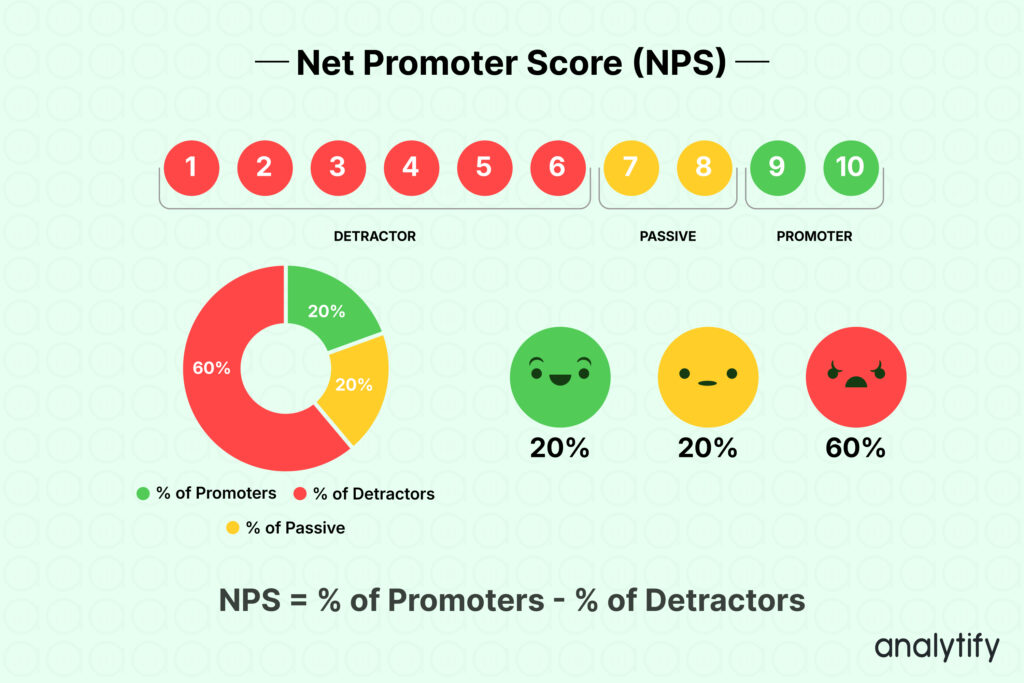
To calculate NPS, you ask customers a single question:
“On a scale of 0 to 10, how likely are you to recommend our company/product/service to a friend or colleague?”
Based on the responses, loyalty, and satisfaction customers are categorized into three groups:
- Promoters: They love your product or service and will likely recommend it to others.
- Passives: They’re satisfied customers but not actively promoting your brand.
- Detractors: These unhappy customers will likely spread negative word-of-mouth about your business.
Example: Let’s say you surveyed 100 customers and got the following results:
- Promoters: 60 customers (60%)
- Passives: 20 customers (20%)
- Detractors: 20 customers (20%)
Your NPS would be:
- NPS = 60 % – 20 %= 40%
An NPS of 40 is generally considered good, but it’s important to compare it to industry benchmarks and track it over time to see if it’s improving. The percentage of Passives is not used in the NPS calculation. By understanding your NPS, you can identify areas for improvement and focus on turning Passives into Promoters while minimizing the number of Detractors.
In Analytify, you can gather the necessary data to determine customer loyalty levels by tracking form submissions and events and creating custom segments. This information can then be used to identify promoters, passives, and detractors.
2. Conversion rate
Conversion rate is the percentage of website visitors who complete a desired action (conversion). This action could be anything from purchasing, signing up for a newsletter, filling out a contact form, or downloading a resource.
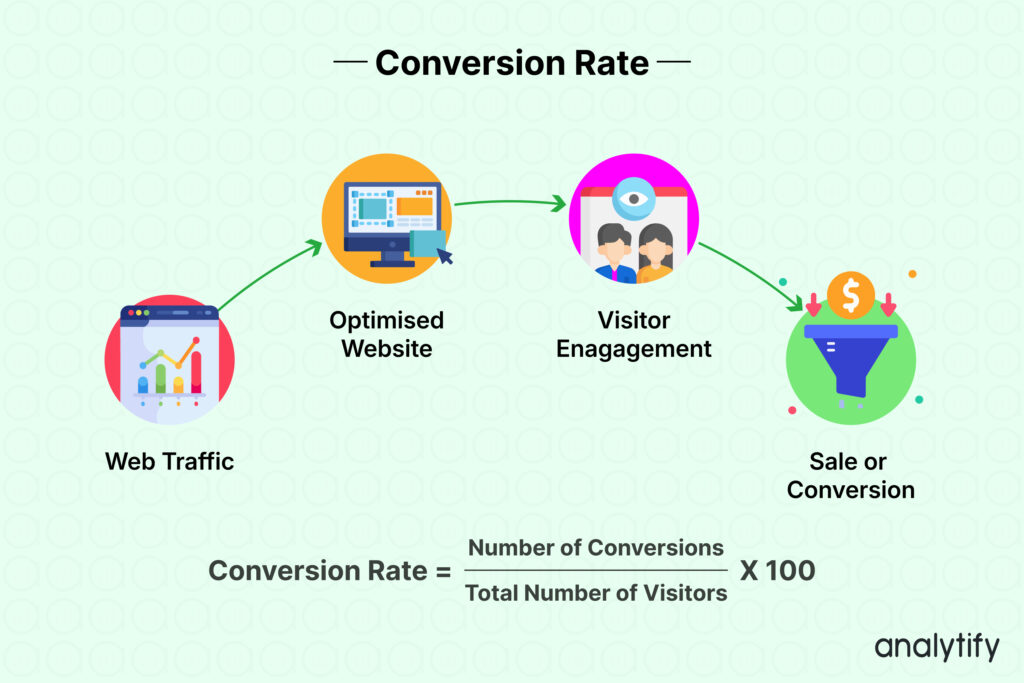
Example: Let’s say an e-commerce website receives 1000 visitors in a month, and 50 of them make a purchase.
- Conversion Rate = (50 / 1000) x 100 = 5%
This means that 5% of the website visitors made a purchase.
Conversion rate is a critical metrics to measure customer engagement. It reflects how well a business is turning website visitors into customers. A high conversion rate indicates strong customer engagement, effective marketing, and a positive user experience. Businesses can optimize their website, marketing campaigns, and overall customer journey to drive sales and revenue growth by analyzing conversion rates.
Analytify’s goal-tracking add-on works with custom dimensions for enhanced conversion rate analysis. It allows you to Analyze conversion rates for specific user segments. For more information about conversion rates, check out this article: Google Analytics Conversion Rate (GA4).
3. Click-Through Rate (CTR)
Click-through rate (CTR) is a metric that measures the percentage of people who click on a specific link or ad compared to the total number of people who see it. It represents the effectiveness of digital advertising and content marketing.
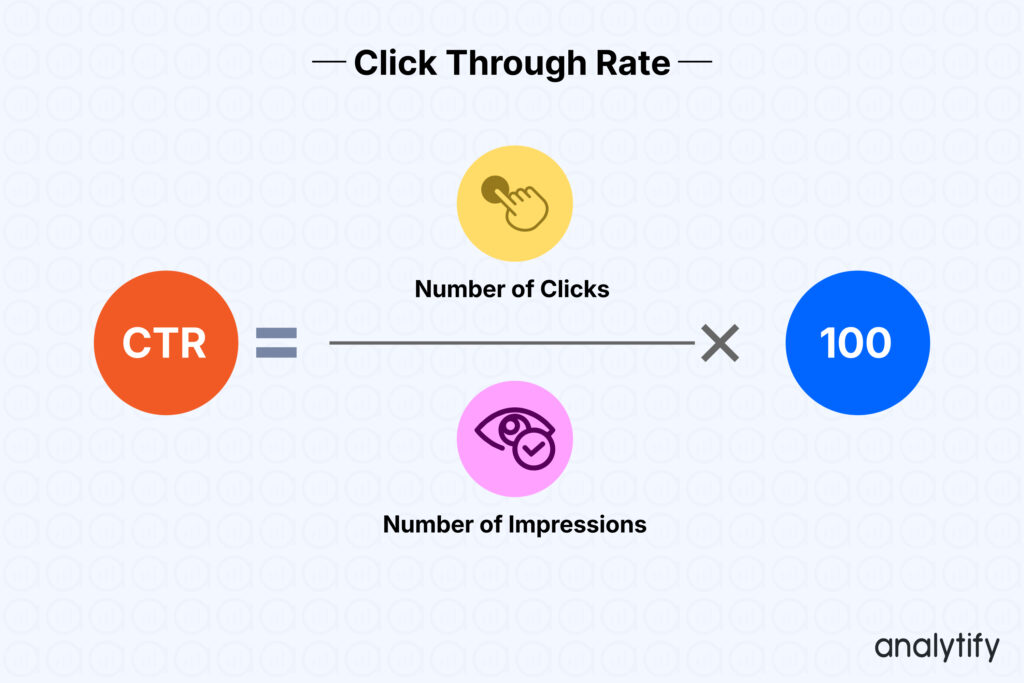
Example: If an ad is displayed 100 times (impressions) and is clicked on 10 times, the CTR would be 10%.
CTR is a crucial metrics for customer engagement because it indicates the effectiveness of content or ad copy. A high CTR suggests that the content or Ad is relevant and engaging, capturing the audience’s attention and encouraging them to take the next step.
By tracking CTR, businesses can Determine which content or ad copy performs best and which needs improvement. They can Allocate resources to high-performing campaigns and refine underperforming ones. They can identify content that drives engagement and tailor future content accordingly. A higher CTR often correlates with increased conversions, as it indicates a stronger interest from the audience.
Analytify can significantly improve your website’s click-through rate (CTR) by Identifying high-performing and low-performing pages to optimize content and calls-to-action. Track clicks from social media platforms to evaluate content performance. By understanding where and when users click, you can refine your content, design, and calls to action to increase CTR and drive more engagement.
4. Customer Satisfaction Score (CSAT)
Customer Satisfaction Score (CSAT) is a metric used to measure customer satisfaction with a product, service, or interaction.
It is typically measured on a scale of 1 to 5 or 1 to 10, with higher scores indicating greater satisfaction. To calculate CSAT, you typically determine the percentage of customers rated their experience as “satisfied” or “very satisfied.”

For example, if you receive 100 responses and 80 customers rate their experience as “satisfied” or “very satisfied,” your CSAT score would be 80%.
CSAT is crucial for understanding customer sentiment and measuring the overall customer experience. A high CSAT score indicates that customers are happy with your product or service and are more likely to become loyal customers and advocates.
Key benefits of tracking CSAT include:
- Identifying areas for improvement: By analyzing CSAT scores, you can pinpoint areas where customer satisfaction is low and address those issues.
- Measuring the impact of changes: CSAT can help you evaluate the effectiveness of changes to products, services, or processes.
- Building customer loyalty: High CSAT scores contribute to customer loyalty and retention.
- Improving customer relationships: By actively seeking and responding to customer feedback, you can strengthen customer relationships.
Ultimately, CSAT is valuable for enhancing customer engagement and driving business growth.
5. Customer Lifetime Value (CLTV)
Customer Lifetime Value (CLTV) is a metric that predicts the total revenue a business can generate from a single customer account.
It’s a crucial indicator of a company’s long-term profitability and customer relationship management effectiveness.

- Average Order Value (AOV): The average amount spent per transaction.
- Purchase Frequency: The number of purchases a customer makes in a specific period.
- Customer Lifespan: The average time a customer remains with the company.
Example:
If a customer spends an average of $100 per purchase (AOV), buys from the company 4 times a year (Purchase Frequency), and stays with the company for 5 years (Customer Lifespan), the CLTV would be:
- CLTV = $100 x 4 x 5 = $2,000
CLTV is a fundamental metric for customer engagement. By understanding a customer’s potential value, businesses can invest more in retaining existing customers than acquiring new ones. CLTV helps determine the maximum amount a company can spend to acquire a new customer.
Businesses can tailor marketing campaigns to increase engagement and loyalty by identifying high-value customers. In essence, CLTV provides a comprehensive view of a customer’s long-term value, guiding businesses in making decisions about customer acquisition, retention, and engagement strategies.
Analytify provides essential data to estimate this metric. To spot valuable segments, you can track user behavior, purchases, and engagement by analyzing purchase frequency, average order value, and customer lifetime. Track repeat purchases and customer churn to estimate customer lifespan.
6. Churn Rate
The churn rate is the percentage of customers who stop doing business with a company within a specific time period. It’s a critical metric for assessing customer retention and the overall health of a business.
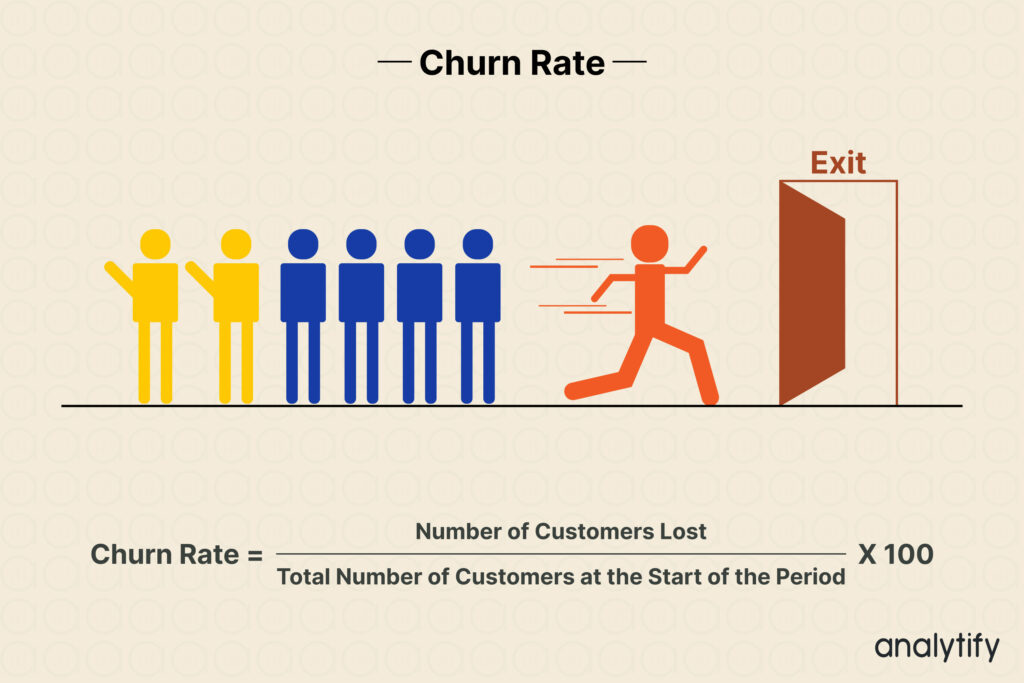
Example
If a company starts with 1000 customers and loses 50 customers over a month, the churn rate would be:
- Churn Rate = (50 / 1000) * 100 = 5%
The churn rate is directly linked to customer engagement. A high churn rate indicates customers are unsatisfied with the product or service and opt to leave. By tracking churn rate, businesses can:
A high churn rate often indicates specific issues, such as poor customer service, product quality problems, or pricing concerns. Companies can implement strategies to retain customers by understanding the reasons for churn.
The churn rate is a crucial component of CLTV calculations. By tracking churn rate over time, businesses can assess the impact of changes to products, services, or customer support.
Ultimately, a low churn rate is essential for long-term business success. It demonstrates strong customer engagement and loyalty.
7. Average Session Duration
Average Session Duration is the average time a user spends on a website during a single visit. It’s a key metric for measuring user engagement and website stickiness.
Formula
Average Session Duration = Total Time Spent on Site / Total Number of Sessions
Example
If 1000 users spend a total of 5000 minutes on a website in a day, the average session duration would be:
- Average Session Duration = 5000 minutes / 1000 sessions = 5 minutes
A higher average session duration generally indicates greater user engagement satisfaction. It suggests that visitors are finding the website content valuable and exciting. By tracking this metric, businesses can Determine if the content is engaging and keeping users on the site.
A low average session duration might indicate issues with website navigation, load times, or content relevance. Make necessary changes to improve website usability and increase time spent. Understand which content or campaigns drive longer sessions and focus on similar efforts.
The average session duration provides valuable knowledge about user behavior and helps businesses enhance the overall customer experience. For a deeper understanding of how visitors interact with your site, check out our detailed guide on average session duration and time on page.
Analytify effectively displays the average session duration metric within its dashboard. By providing this information in a user-friendly format, Analytify empowers you to assess the overall engagement of your website visitors quickly.
8. Customer Retention Rate
Customer Retention Rate is the percentage of customers who continue to do business with a company over a specific period. It measures the company’s ability to retain its customer base.
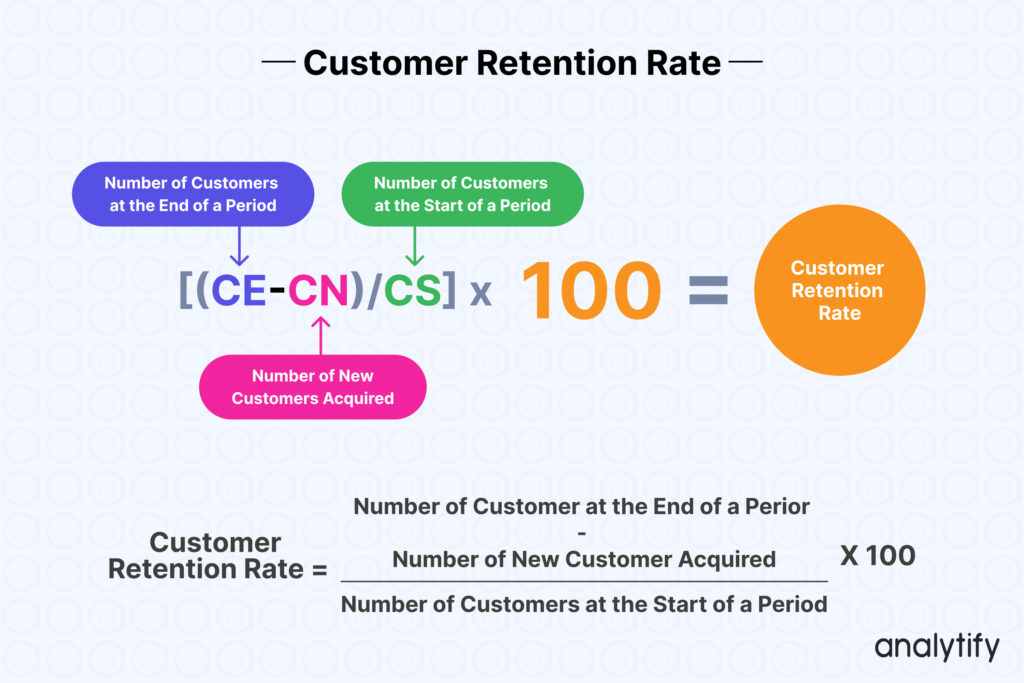
Example
Let’s say a company starts with 1000 customers, acquires 50 new customers, and ends the period with 920 customers. The retention rate would be:
Retention Rate = [(920 – 50) / 1000] x 100 = 87%
Customer retention is crucial for business success. Retaining existing customers is generally less expensive than acquiring new ones. By tracking customer retention, businesses can Measure customer loyalty. A high retention rate indicates strong customer satisfaction and loyalty.
A declining retention rate can signal product, service, or customer experience issues. Customer retention is a key indicator of customer engagement and overall business health.
To improve customer retention rate, you have to provide good customer service and regular updates. You can also create a knowledge base to solve common problems and answer frequently asked questions.
Analytify provides essential user behavior data to estimate customer retention rates. By tracking user sessions, page views, and goal completions, you can identify patterns and segment customers to understand loyalty.
9. Customer Effort Score (CES)
Customer Effort Score (CES) measures how easy it is for customers to interact with a company. It focuses on the effort customers exert to resolve an issue, complete a task, or get an answer to a question.
Unlike other metrics, CES doesn’t have a specific formula. Instead, it’s calculated based on the percentage of customers who rated their experience as “very easy” or “easy.”
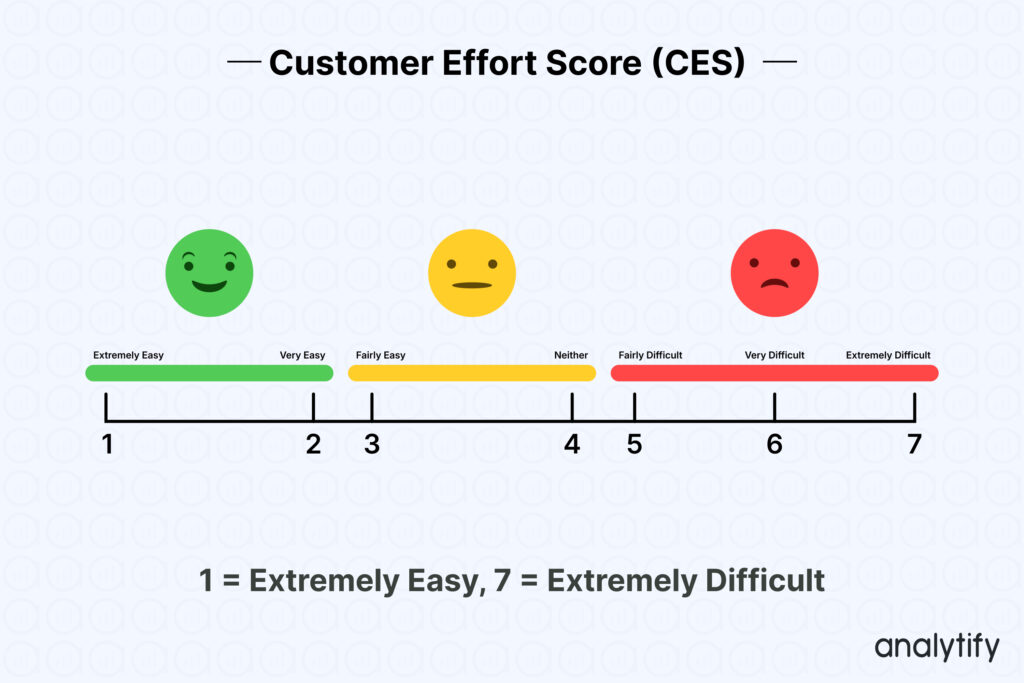
Example
A typical CES question might be: “On a scale of 1 to 7, how easy was it to resolve your issue today? (7 = very difficult, 1 = Extremely easy)”
If 70% of customers rate their experience as “very easy” or “easy,” the CES score is 70%.
CES is an essential metric for understanding customer experience. It directly correlates with customer loyalty and satisfaction. A low CES indicates customers are struggling, which can lead to churn. Key benefits of tracking CES include:
- Identifying pain points: Highlighting areas where customers face difficulties.
- Improving customer experience: Focusing on reducing customer effort can significantly enhance satisfaction.
- Predicting customer loyalty: A low-effort experience often leads to higher customer loyalty.
- Measuring the impact of changes: Assessing the effectiveness of changes made to improve customer experience.
By prioritizing a low-effort customer experience, businesses can build stronger customer relationships and increase retention. By combining Analytify event tracking, form tracking, and custom dimension data with external surveys or feedback tools, you can calculate CES and identify areas where customer effort can be reduced.
10. Bounce Rate
Bounce rate is the percentage of website visitors who leave a website after viewing only one page. It’s a measure of how engaging your content is.
Formula
Bounce Rate = (Number of Single-Page Visits / Total Number of Visits) x 100
Example
If a website receives 1000 visitors and 300 of them leave after viewing only one page, the bounce rate is:
- Bounce Rate = (300 / 1000) * 100 = 30%
A high bounce rate can indicate several issues, including:
- Poor website design: Navigation might be confusing or difficult to use.
- Irrelevant content: The content might not match the visitor’s expectations or interests.
- Slow loading times: Visitors might get impatient and leave before the page loads.
- Technical issues: Broken links or errors can frustrate visitors.
By tracking bounce rate, businesses can Identify page problems, Improve website usability, Enhance content relevance, and ultimately Optimize website performance. A low bounce rate suggests that visitors find the website engaging and valuable, leading to increased time spent on the site and potentially higher conversion rates.
Implementing bounce rate tracking configurations in GA4 can be technically demanding for those without a strong analytics background. Analytify, specifically designed for WordPress, offers a more streamlined approach to measuring bounce rate. It can be observed easily on the wordpress dashboard.
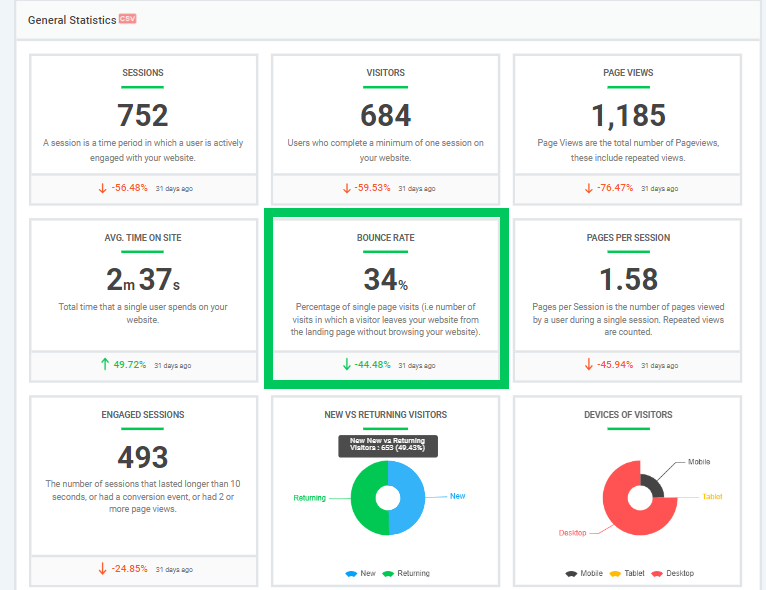
For more tips on reducing your website’s bounce rate, see this article: How to Reduce Bounce Rate (20 Quick Tips).
11. Pages Per Session
Pages per session is a metric that measures the average number of pages a visitor views during a single session on a website.
Formula
Pages per session = Total number of pageviews / Total number of sessions
Example
If a website has 1000 pageviews in a day and 500 sessions, the pages per session would be:
- Pages per session = 1000 / 500 = 2
This means that each visitor viewed 2 pages on average during their session.
Pages per session are a crucial indicator of user engagement. A higher number generally indicates that visitors find the website content interesting and engaging, leading them to explore further.
By tracking pages per session, businesses can Evaluate content effectiveness. Determine if the content is compelling enough to encourage further exploration.
A low number of pages per session might indicate problems with website navigation. Make changes to encourage users to explore more pages. This metric can measure marketing campaign success and determine whether marketing efforts drive deeper engagement. Ultimately, more pages per session indicate a better user experience and increased conversion potential.
While Google Analytics provides valuable information, it has some limitations when measuring pages per session. If a user is inactive for a certain period, the session ends, potentially undercounting pages per session. By overcoming these limitations, Analytify employs advanced tracking methods to offer a more accurate and reliable measurement of pages per session.
Analyze Customer Engagement Metrics With Analytify
Analytify is a powerful, user-friendly WordPress plugin that makes Google Analytics data easily understandable. Let’s explore some of its general features and the customer engagement metrics it helps you monitor.
Join 50,000+ beginners & professionals who use Analytify to simplify their Google Analytics!
- User-Friendly Dashboard: The plugin offers an intuitive and easy-to-navigate dashboard, providing a clear overview of your website’s performance metrics.

- Real-Time Statistics: View real-time data on your website traffic, including the number of visitors, page views, and active users.

- Bounce Rate Analysis: Measure and analyze the bounce rate to understand how many visitors leave your site after viewing only one page.
- Engagement Metrics: You can observe The following important metrics in the Analytify dashboard.
- Session duration
- Engaged session
- Page views
- Pages per session
- Average time on site
- Session
- Visitors
- New vs returning users
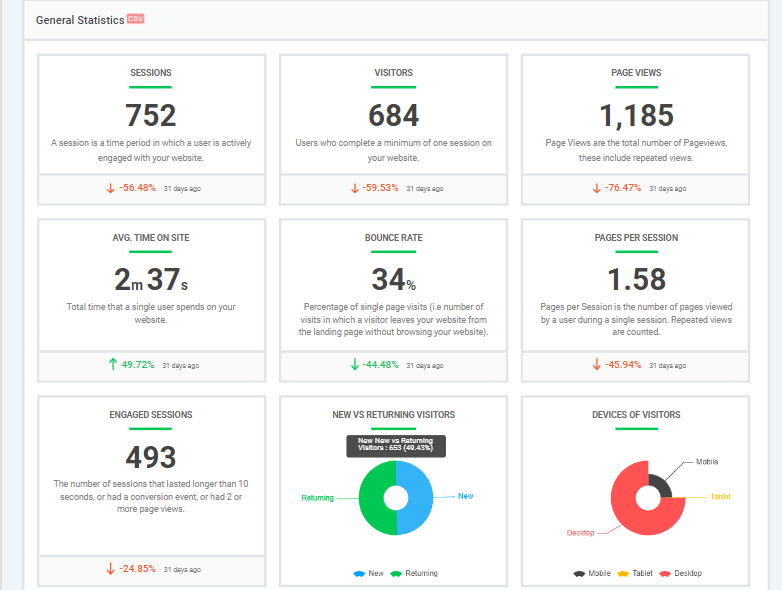
- Conversion Tracking: Monitor conversion rates by tracking goal completions, such as form submissions, downloads, and purchases.
- Social Media Engagement: Analyze traffic and engagement from various social media platforms to understand which channels drive the most engagement.

- Events Tracking: With the event tracking add-on, monitor specific user actions on your site, such as video plays, button clicks, and other interactive elements, to understand engagement with different features.
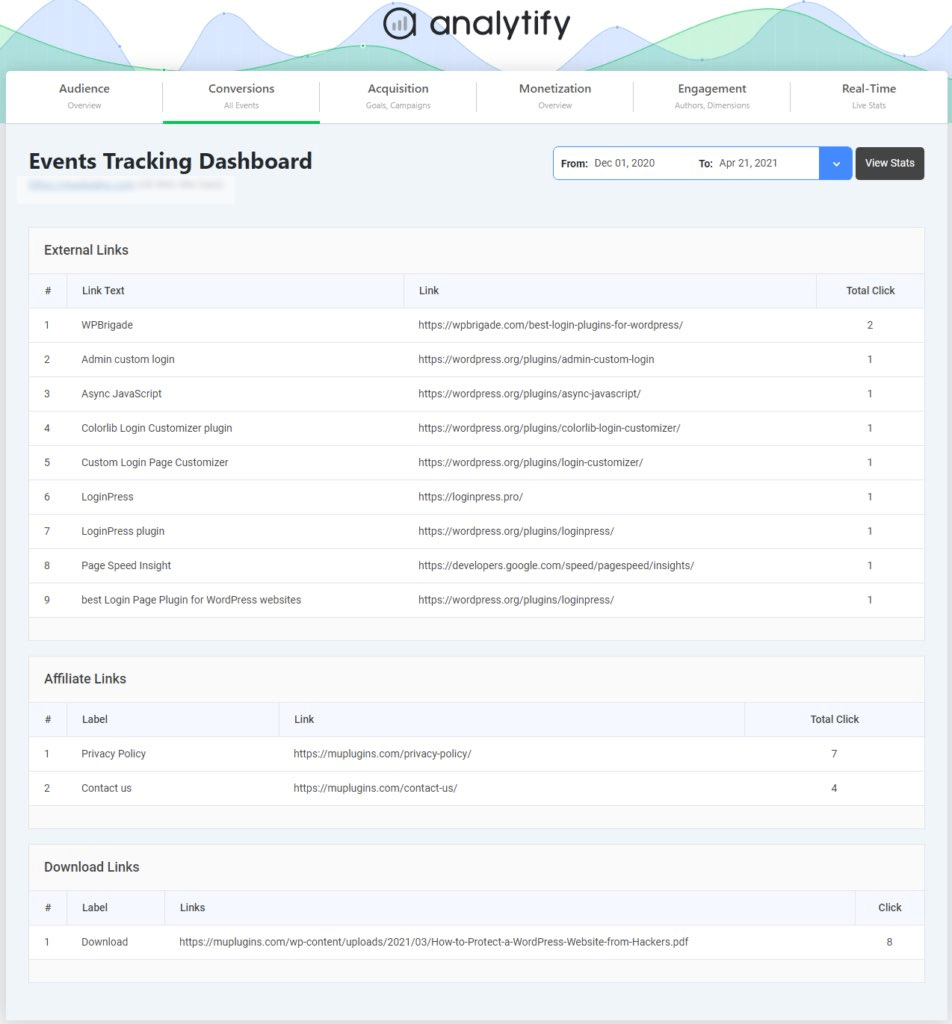
- Visitor Behavior Analysis: Track how users interact with your website, including pages visited, time spent on each page, and navigation paths.
- Campaign Tracking: Analytify UTM Campaign tracking add-on, track campaign performance, social media traffic, and other marketing efforts with detailed analytics.
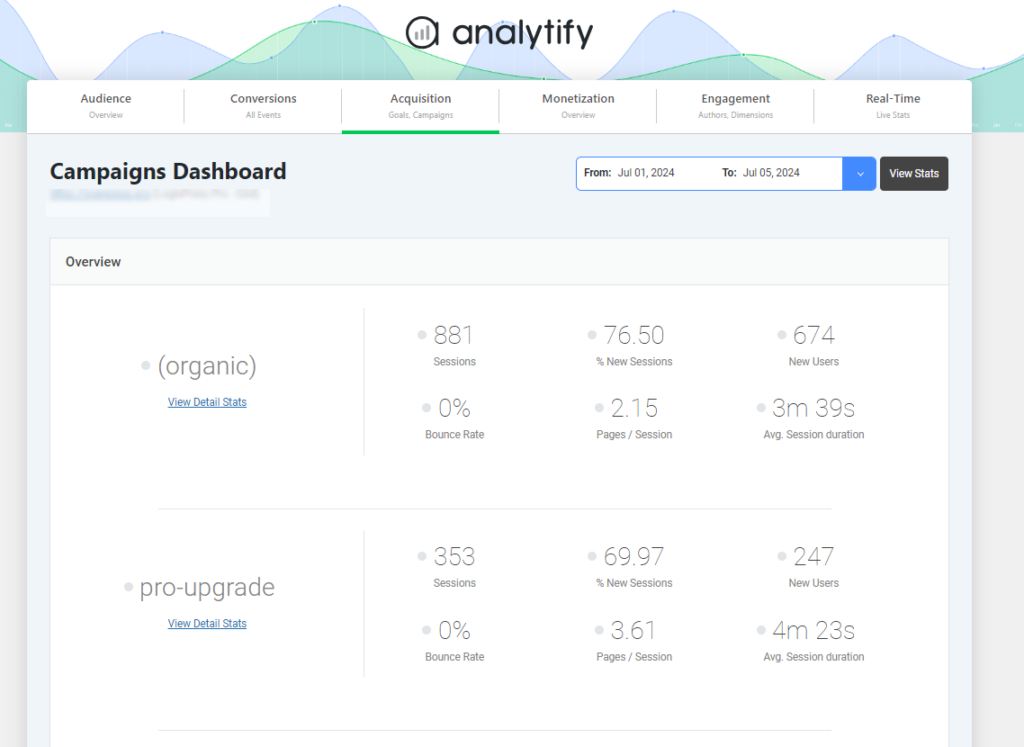
- E-commerce Tracking: If you have an online store, Analytify WooCommerce tracking Add-on helps to track e-commerce data, including transactions, revenue, and product performance

Other Advanced Features
- Automated Reports: Generate automated email reports via Email Notification Add-on that summarize your website’s key performance indicators and can be sent daily, weekly, or monthly.
- User Demographics and Interests: Understanding your visitors’ demographics and interests will allow for more targeted marketing strategies.
- Referral Traffic: See which external sites and sources are driving traffic to your website, helping you identify valuable partnerships and referral opportunities.
So, Analytify empowers you to effortlessly track and analyze these user engagement metrics to boost your business growth.
Customer Engagement Metrics FAQ
1. How does customer engagement impact business performance?
High customer engagement typically leads to increased customer loyalty, higher retention rates, more positive referrals, and increased sales and revenue. Engaged customers are more likely to provide valuable feedback and contribute to product and service improvements.
2. What tools can I use to track customer engagement metrics?
Many tools are available, including Analytify, Google Analytics, CRM software, social media analytics, and customer feedback platforms.
3. How do I choose the right customer engagement metrics to track?
Start by defining your business goals and identifying the key metrics that align with those goals. For example, if increasing sales is the goal, track conversion rate and average order value.
4. What are some key social media engagement metrics?
The social media engagement metrics are the following:
Likes: Shows approval or interest.
Shares: Indicates content is valuable enough to share with others.
Comments: Demonstrates audience interaction and provides feedback.
Click-through rates: Measures the effectiveness of your content in driving traffic to your website.
Mentions: Shows how often your brand is discussed.
5. How often should I track customer engagement metrics?
The frequency of tracking depends on your business and industry. However, it is generally recommended that you track metrics regularly, such as weekly or monthly, to identify trends and make timely adjustments.
6. How can I increase social media engagement?
You can increase social media Engagement by these tips :
Create high-quality content: Share valuable, interesting, and visually appealing content.
Encourage interaction: Ask questions, run contests, and respond to comments promptly.
Use relevant hashtags: Help people discover your content.
Post consistently: Maintain a regular posting schedule.
Analyze your audience: Understand your target audience so that you can tailor content accordingly.
7. What are key email engagement metrics?
The following are the key email engagement metrics:
Open rate: Percentage of recipients who opened your email.
Click-through rate (CTR): Percentage of recipients who clicked on a link.
Click-to-open rate (CTOR): Percentage of opens that resulted in a click.
Bounce rate: Percentage of emails undelivered.
Unsubscribe rate: Percentage of subscribers who opted out.
Customer Engagement Metrics: Recap
Now that we’ve covered the essential customer engagement metrics, let’s wrap things up. Understanding these metrics is crucial for optimizing your customer interactions and ensuring a robust engagement strategy.
Page views and session duration reveal how long users stay on your site and how much content they consume, while the bounce rate measures the frequency of users leaving after viewing only one page. The conversion rate is pivotal for tracking desired user actions. Customer satisfaction scores (CSAT) gauge overall satisfaction, and net promoter scores (NPS) indicate customer loyalty and the likelihood of recommendations. Customer effort scores (CES) evaluate the ease of customer interactions, and the churn rate monitors the percentage of customers leaving your service.
By closely monitoring these user engagement metrics, you can refine your strategies to foster stronger customer relationships and drive engagement.
Check out our article on How to Improve Google Analytics 4 Engagement Rate (Easy Guide) for practical tips and strategies to boost your engagement metrics effectively.
If you have any questions, don’t hesitate to let us know! Leave a comment below, and let us keep the conversation going!




